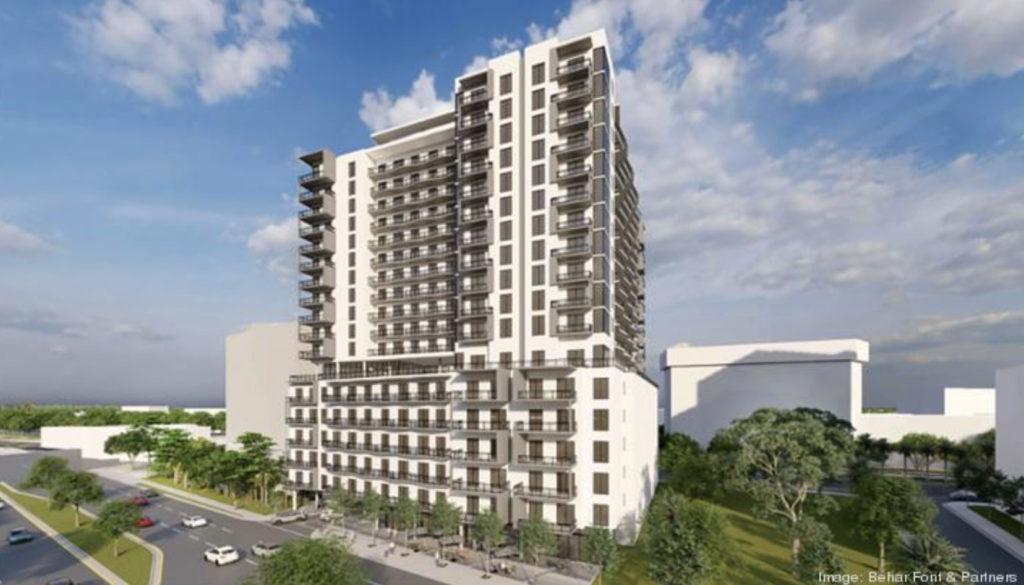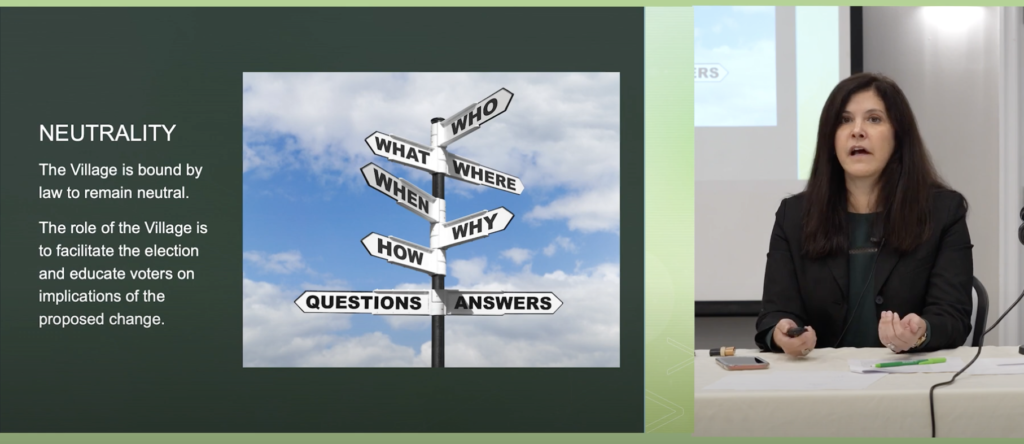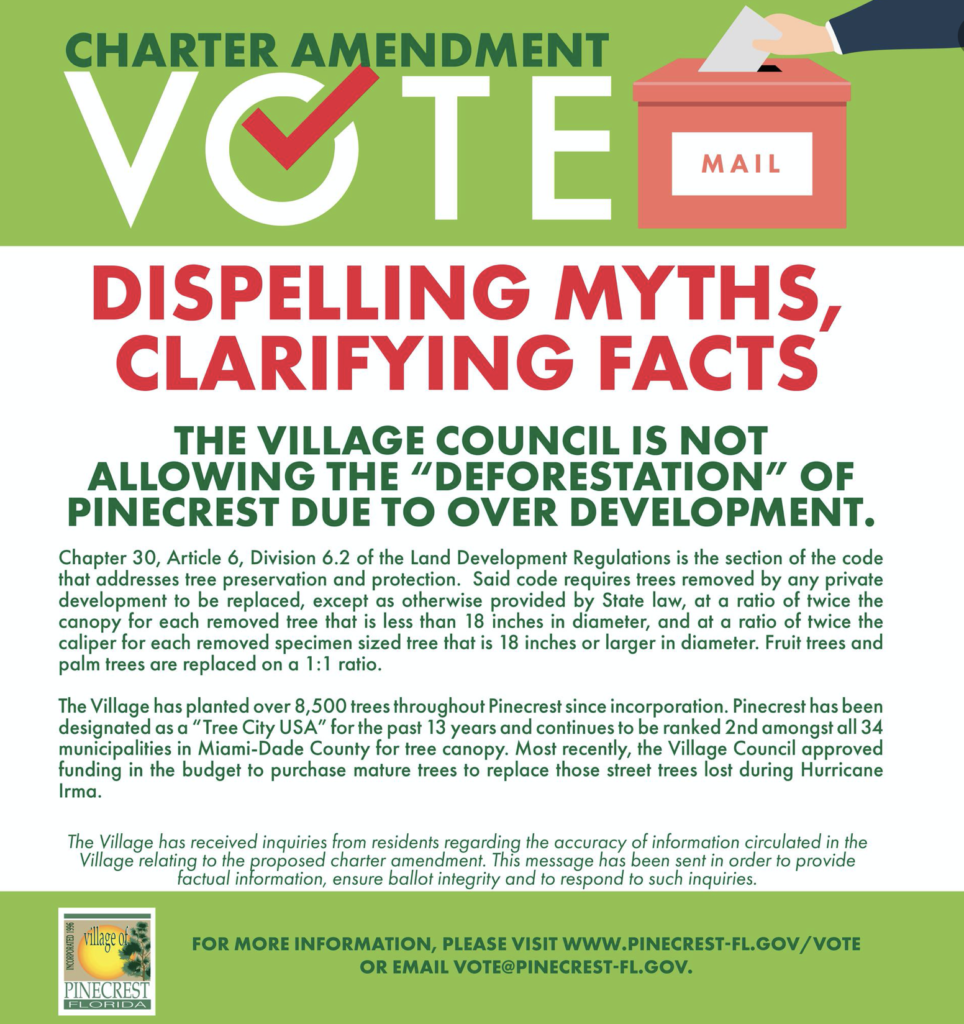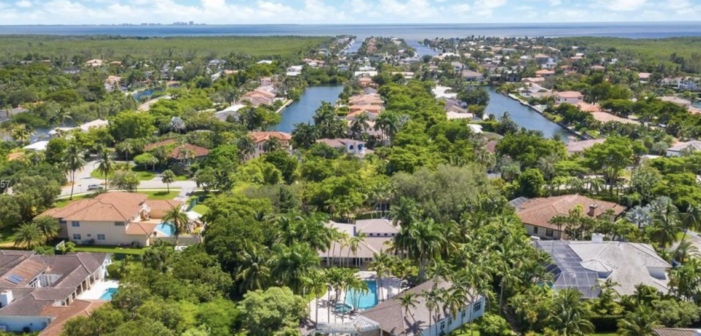Pinecrest voters have the chance to get more control over development in their village through a referendum that would require a public vote for practically all zoning code and land use changes. If it passes next week, any attempt to increase density, height and floor area ratio, or to create new zoning districts — or even change a definition in the zoning code — would have to be approved by 60% of voters.
Pinecrest electeds are livid that they are losing that power.
Last month, the village council voted unanimously to oppose the referendum. At the heated meeting, Mayor Joseph “Joe“ Corradino wondered out loud if he could sue critics for slander, and the activist who formed the Concerned Citizens of Pinecrest, which petitioned to put the referendum on the March 7 ballot, was escorted out by police. People who were there told Ladra the woman disrupted the Jan. 10 meeting.
But Corradino reminded everyone at the beginning of that council meeting that there are decorum rules. So he must have expected a problem.
The potential change has become a power struggle among residents and the electeds and has divided the small town like nothing has before. The Next Door app está en llamas.
It began when the visioning process for the U.S. 1 corridor started last year, said Village Manager Yocie Galiano. Concerned citizens asked village officials to slow everything down. They did, Galiano said. They asked village officials to consider limiting everything to four stories. They did.
At the same time, the county, through Miami-Dade Commission Chair Oliver Gilbert, was pushing for a new rapid transit zoning overlay that would promote increased density — workforce housing and mixed use commercial — near transit hubs, like the Dadeland South Metrorail station. Before it got watered down so municipalities had more control in their areas, Pinecrest residents envisioned high-rises near Downtown Dadeland and at the site of the Captain’s Tavern shopping center. Kind of like the 18-story Pinecrest Walk apartments planned across the street in unincorporated Miami-Dade, to replace a KFC and carwash on the west side of the highway.

In the end, the village created the Pinecrest business overlay district, which limits commercial buildings on U.S. 1 to four stories. But some residents fear that this could change with a majority vote.
The referendum “puts the power in the hands of the residents because we no longer trust your judgement,” Laura McNaughton said at the January meeting, adding that it mirrored the Key Biscayne process and that the village charter allows residents to petition for a referendum. (But Key Biscayne only has a 50.01% passage.)
“Let the residents vote,” she said. “It’s how the charter was written so we could change and address laws.”
McNaughton says the village officials and council members are scaring everyone into thinking “every little thing has to go to a vote.”
Village Manager Yocie Galiano told Ladra that while not everything will go to a vote, too many things will, including the change in any definition under zoning and land use items, something she says happens often. Recently, for example, the village changed the definition of family to regulate sober homes and rooming houses, she said.
Sober homes and rooming houses in Pinecrest? No, they don’t allow it. “Because we changed the definition we can disallow those uses,” Galiano said.
Galiano also said that a special election could cost the village between $20,000 and $65,000, depending if it was mail-in only or in-person. “Each time we will have to do an educational campaign which we anticipate will cost another $35,000,” she told council members on Jan. 10.
In this instance, the village has spent around $145,000 on developing the ballot language and their “educational campaign” for next week’s referendum, which obviously advocates a hard no.

To “educate the public,” the city posted a lot of information — frequently asked questions, a video explanation, a “myths and clarifications” page — on the village website. For example, Corradino is not the mayor for life, it says. Galiano and Village Attorney Chad Friedman made a 30-minute video explaining the charter amendment and it’s consequences. They also held five town hall meetings.
“We are here to help educate you. Our position is neutral. We are not going to debate anything,” Galiano says in it.
“None of the things we are providing are opinions. It’s all based on facts,” she told Ladra. “We have an obligation to make sure there is integrity in the election. When there’s a lot of misinformation, we have to clarify what the facts are.”
The Village take is that this change is unnecessary. Residents can already appeal a zoning change and reject it with a 50.01% vote. The limit on buildings along U.S.1, the village’s business area, is four stories. It tiers down to two stories where it is adjacent to residential areas.
Councilwoman Shannon Del Prado calls the referendum “a nuclear solution in search of a problem.
“Pinecrest is not broken. Our charter does not need fixing,” she wrote in a Community Newspapers column.

The village is not the only one spending money on voter outreach. There are two political action committees pulling for each side. Citizens for Preserving Pinecrest represents the Yes side that put the petition together. Friends of Pinecrest represents the No side.
As of Feb. 10, according to the campaign finance reports, the Citizens group raised $42,700 and spent $36,279. The Friends PAC raised just over $15K — contributors include Corradino and Councilwoman Anna Hochkammer as well as former mayor Evelyn Greer — and spent $12,658.
The official ballot language for the Pinecrest referendum:
The charter amendment would require 60 percent voter approval for text amendments to the zoning code or land development regulations that would create a new zoning district, amend any definition in the land development regulations, or have the effect of allowing uses not currently permitted, increase residential density, allow additional hotel or accommodation units per acre, increase lot coverage, increase height, or increase floor area ratio.
As of Wednesday, 5,199 people had voted in the mail-in only election. There are 13,158 registered voters in Pinecrest, so turnout is 39% and climbing.
There will be no in-person voting. Mail-in ballots must be received at the Miami-Dade County Elections Department by 7 p.m. Tuesday, March 7.

